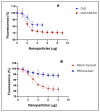Copolymer-Green-Synthesized Copper Oxide Nanoparticles Enhance Folate-Targeting in Cervical Cancer Cells In Vitro
- PMID: 37242968
- PMCID: PMC10223539
- DOI: 10.3390/polym15102393
Copolymer-Green-Synthesized Copper Oxide Nanoparticles Enhance Folate-Targeting in Cervical Cancer Cells In Vitro
Abstract
Cervical cancer is fast becoming a global health crisis, accounting for most female deaths in low- and middle-income countries. It is the fourth most frequent cancer affecting women, and due to its complexity, conventional treatment options are limited. Nanomedicine has found a niche in gene therapy, with inorganic nanoparticles becoming attractive tools for gene delivery strategies. Of the many metallic nanoparticles (NPs) available, copper oxide NPs (CuONPs) have been the least investigated in gene delivery. In this study, CuONPs were biologically synthesized using Melia azedarach leaf extract, functionalized with chitosan and polyethylene glycol (PEG), and conjugated to the targeting ligand folate. A peak at 568 nm from UV-visible spectroscopy and the characteristic bands for the functional groups using Fourier-transform infrared (FTIR) spectroscopy confirmed the successful synthesis and modification of the CuONPs. Spherical NPs within the nanometer range were evident from transmission electron microscopy (TEM) and nanoparticle tracking analysis (NTA). The NPs portrayed exceptional binding and protection of the reporter gene, pCMV-Luc-DNA. In vitro cytotoxicity studies revealed cell viability >70% in human embryonic kidney (HEK293), breast adenocarcinoma (MCF-7), and cervical cancer (HeLa) cells, with significant transgene expression, obtained using the luciferase reporter gene assay. Overall, these NPs showed favorable properties and efficient gene delivery, suggesting their potential role in gene therapy.
Keywords: cervical cancer; copper oxide; cytotoxicity; folate targeting; gene delivery; green synthesis.
Conflict of interest statement
The authors declare no conflict of interest.
Figures










References
-
- World Health Organization Cervical Cancer. [(accessed on 20 February 2023)]. Available online: https://www.who.int/health-topics/cervical-cancer#tab=tab_1.
Grants and funding
LinkOut - more resources
Full Text Sources

